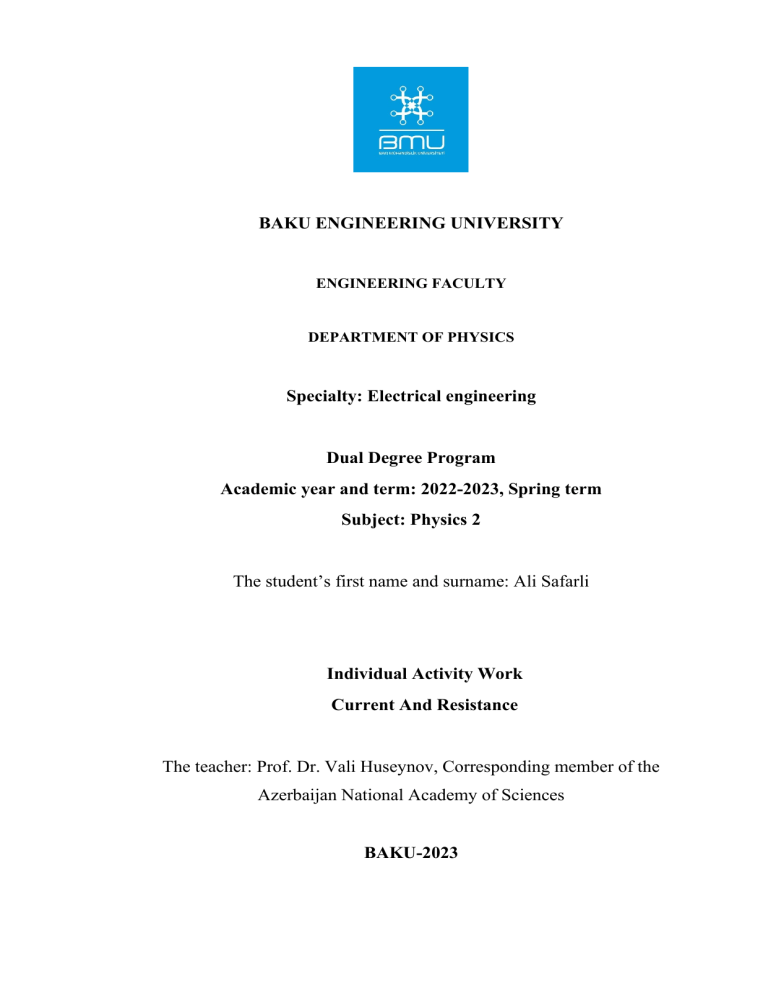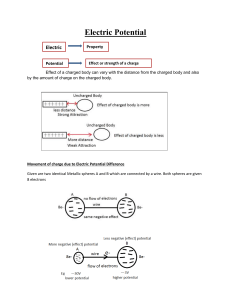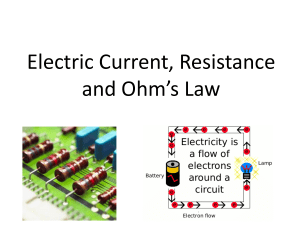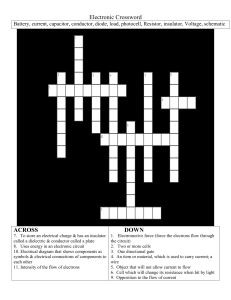Current and Resistance Ali Safarli's Individual Activity Work copy
advertisement

BAKU ENGINEERING UNIVERSITY ENGINEERING FACULTY DEPARTMENT OF PHYSICS Specialty: Electrical engineering Dual Degree Program Academic year and term: 2022-2023, Spring term Subject: Physics 2 The student’s first name and surname: Ali Safarli The student’s e-mail address: eseferli4@std.beu.edu.az Individual Activity Work Current And Resistance The teacher: Prof. Dr. Vali Huseynov, Corresponding member of the Azerbaijan National Academy of Sciences BAKU-2023 Current and Current density In the modern world electric currents abound and involve many professions. Medical technology biologists, physiologists, and engineers are interested in the nerve currents that drive muscles, specifically how such currents might be restored following spinal cord injury. Numerous electrical systems, including power systems, lightning protection systems, information storage systems, and music systems, are of interest to electrical engineers. Because the passage of charged particles from our sun has the potential to destroy power transmission systems on Earth as well as telecommunication equipment in orbit, space experts closely monitor and analyze this flow. Meteorologists are concerned with lightning and the less dramatic gradual passage of charge through the atmosphere. Space engineers watch and examine the passage of charged particles from our Sun since it has the potential to destroy telecommunications equipment in space as well as power transmission systems on Earth. Aside from scholarly research, practically every element of daily life today relies on information carried by electric currents, from stock trading to ATM transfers, and from video entertainment to social networking. In this individual activity we discuss the basic physics of electric currents and why they can be established in some materials but not in others. Although a stream of moving charges makes up an electric current, not all moving charges are included in an electric current. There must be a net flow of charge across the surface for there to be an electric current to flow through it. Two illustrations help to make our point. 1. In an isolated length of copper wire, the free electrons (conduction electrons) are moving at random speeds of around 106 m/s. Conduction electrons run through such a wire in both directions if you pass a hypothetical plane across it at a rate of several billions of times per second, yet there is no net charge transfer and no current flowing down the wire as a result. But if you attach the wire's ends to a battery, you'll slightly bias the flow in that direction, which will result in a net transfer of charge and an electric current flowing through the wire. 2. Water flowing through a garden hose symbolizes the directed flow of positive charge (protons in water molecules) at a rate of millions of coulombs per second. However, there is no net charge transfer since there is a parallel flow of negative charge (the electrons in the water molecules) of the same quantity traveling in the same direction. As seen in the next picture a, any isolated conducting loop, regardless of whether it carries an excess charge, is all at the same potential. There can be no electric field within it or along its surface. Even though conduction electrons are accessible, there is no net electric force acting on them, hence there is no current. If we place a battery into the loop, as shown in the next picture b, the conducting loop is no longer at a single potential. Electric fields act within the loop's material, putting pressures on conduction electrons, forcing them to migrate and thereby producing a current. After a relatively short period, the electron flow has reached a constant value, and the current has reached a steady state (it does not change with time). The next picture depicts a conductor segment that is part of a conducting loop in which current has been created. If at time dt, charge dq flows through a hypothetical plane (such as aa′), the current i via that plane is defined as: 𝑖𝑖 = 𝑑𝑑𝑑𝑑 𝑑𝑑𝑑𝑑 We can find the charge that passes through the plane in a �me interval extending from 0 to t by integra�on: 𝑡𝑡 𝑞𝑞 = ∫ 𝑑𝑑𝑑𝑑 = ∫0 𝑖𝑖 𝑑𝑑𝑑𝑑 , in which the current i may vary with �me. Under steady-state circumstances, the current is the same for planes aa′, bb′, and cc′, as well as any planes that travel entirely through the conductor, regardless of position or orientation. This is because charge is preserved. An electron must pass through plane aa- for every electron that goes through plane cc′ under the steady-state circumstances indicated here. Similarly, if there is a constant flow of water through a garden hose, a drop of water must leave the nozzle for every drop that enters the hose at the other end. The quantity of water in the hose is preserved. The SI unit for current is the coulomb per second, which is also a SI base unit: 1 ampere = 1 A = 1 coulomb per second = 1 C/s The next picture depicts a conductor with current i0 breaking into two branches at a junction. Because charge is conserved, the magnitudes of the currents in the branches must sum to provide the amplitude of the current in the original conductor, implying that. i₀ = i₁ + i₂ Bending or reorienting the wires in space, as shown in the next picture, has no effect on the validity of previous equation Current arrows only depict a direction (or feeling) of flow along a conductor, not a spatial direction. A current arrow is drawn in the direction in which positive charge carriers would move, even if the actual charge carriers are negative and move in the opposite direction. Current density We are sometimes interested in the current i in a certain conductor. At times, we use a more limited approach and investigate the flow of charge across a cross section of a conductor at a specific place. We may use the current density to characterize this flow, which has the same direction as the velocity of the flowing charges if they are positive and the opposite way if they are negative. The magnitude J of each cross-section element is equal to the current per unit area across that element. The amount of current flowing through the element may be written as where is the element's area vector perpendicular to the element. The total current through the surface is then calculated. 𝑖𝑖 = ∫ 𝐽𝐽⃗ ∗ 𝑑𝑑𝐴𝐴⃗ If the current is uniform across the surface and parallel to dA then J is also uniform and parallel to then 𝑖𝑖 = 𝐽𝐽 ∗ 𝐴𝐴 , 𝐽𝐽 = 𝑖𝑖 𝐴𝐴 When an electric field E is established in a conductor, the charge carriers (assumed positive) acquire a drift speed vd in the direction of the velocity is related to the current density by 𝐽𝐽⃗ = (ne)𝑣𝑣⃗d where ne is the carrier charge density. Resistant and Resistivity When we apply the same potential difference between the ends of geometrically similar copper and glass rods, we get significantly different currents. The electrical resistance of the conductor that enters here is a property. We may calculate the resistance between any two places on a conductor by applying a potential difference V between them and measuring the resulting current i. The resistance R is then calculated. 𝑅𝑅 = 𝑉𝑉 𝑖𝑖 The volt per ampere is the SI unit for resistance derived from there. This combination happens so frequently that it has its own name, the ohm (symbol Ω). 1 ohm = 1 Ω = 1 volt per amper = 1 V/A A conductor whose function in a circuit is to provide a specified resistance is called a resistor. We frequently want to take a broad view and deal with materials rather than specific things, as we have done in previous contexts. In this case, we do so by focusing on the electric field at a spot in a resistive material rather than the potential difference V across a specific resistor. We deal with the current density at the place in issue rather than the current i via the resistor. Instead of dealing with an object's resistance R, we deal with the material's resistivity r: 𝜌𝜌 = 𝐸𝐸 𝐽𝐽 If we combine the SI units of E and J, we get, for the unit of r, the ohmmeter (Ω *m): 𝑉𝑉 ⁄𝑚𝑚 𝑉𝑉 𝑢𝑢𝑢𝑢𝑢𝑢𝑢𝑢(𝐸𝐸) = = 𝑚𝑚 = Ω ∗ m 𝐴𝐴 𝑢𝑢𝑢𝑢𝑢𝑢𝑢𝑢(𝐽𝐽) 𝐴𝐴⁄𝑚𝑚2 We can write previous equation in vector form as: 𝐸𝐸�⃑ = 𝜌𝜌 ∗ 𝐽𝐽⃗ We often speak of the conductivity s of a material. This is simply the reciprocal of its resistivity, so: σ = 1 𝜌𝜌 The SI unit of conductivity is the reciprocal ohmmeter (Ω ∗ 𝑚𝑚)−1 . The unit’s name mhos per meter is sometimes used (mho is ohm backwards). The definition of s allows us to write previous Equation the alternative form: 𝐽𝐽⃗ = 𝜎𝜎𝐸𝐸�⃗ However, V/i is the resistance R, which allows us to recast Equation of resistance as: 𝑅𝑅 = 𝜌𝜌 𝐿𝐿 𝐴𝐴 Change of ρ with Temperature The resistivity ρ for most materials changes with temperature. For many materials, including metals, the relation between ρ and temperature T is approximated by the equation: 𝜌𝜌 − 𝜌𝜌₀ = 𝜌𝜌₀𝑎𝑎(𝑇𝑇 − 𝑇𝑇₀) Here T₀ is a reference temperature, ρ₀ is the resistivity at T₀, and α is the temperature coefficient of resistivity for the material. Ohm's Law is a fundamental principle in electrical engineering and physics that relates the voltage, current, and resistance in an electrical circuit. It provides a mathematical relationship between these three parameters and is named after the German physicist Georg Simon Ohm, who first formulated the law. In its simplest form, Ohm's Law states that the current flowing through a conductor is directly proportional to the voltage applied across it and inversely proportional to the resistance of the conductor. Mathematically, it can be expressed as: Where: 𝑉𝑉 = 𝐼𝐼 ∗ 𝑅𝑅 V represents the voltage across the conductor, I represents the current flowing through the conductor, and R represents the resistance of the conductor. According to Ohm's Law, if the voltage applied to a conductor is increased while the resistance remains constant, the current flowing through the conductor will also increase. Conversely, if the voltage is decreased, the current will decrease proportionally. The law can also be rearranged to calculate other parameters. For example, if the current and resistance are known, the voltage can be calculated using the equation: 𝑉𝑉 = 𝐼𝐼 / 𝑅𝑅 Similarly, if the voltage and current are known, the resistance can be calculated using the equation: 𝑅𝑅 = 𝑉𝑉 / 𝐼𝐼 It is important to note that Ohm's Law holds true for linear, passive elements such as resistors. It does not apply to non-linear elements like diodes or transistors. Additionally, it assumes that the temperature and other environmental factors remain constant. Ohm's Law serves as a foundational principle for many advanced topics in electrical engineering, including circuit analysis, power calculations, and circuit design. It forms the basis for numerous calculations and concepts used in practical applications such as power distribution, electronic devices, and telecommunications. Resistivity of a Metal By assuming that the conduction electrons in a metal are free to move like the molecules of a gas, it is possible to derive an expression for the resistivity of a metal: 𝜌𝜌 = 𝑚𝑚 𝑒𝑒 2 𝑛𝑛τ Here n is the number of free electrons per unit volume and t is the mean time between the collisions of an electron with the atoms of the metal. We can explain why metals obey Ohm’s law by pointing out that τ is essentially independent of the magnitude E of any electric field applied to a metal. The picture below depicts a circuit consisting of a battery B linked to an unnamed conducting device through wires with minimal resistance. A resistor, a storage battery (a rechargeable battery), a motor, or another electrical device might be used. The battery maintains a potential difference of magnitude V across its own terminals and hence (due to the cables) across the terminals of the unknown device, with a bigger potential at terminal a than terminal b. Because there is an external conducting channel between the battery's two terminals and the potential differences created by the battery are preserved, In the circuit, a constant current i flows from terminal a to terminal b. The charge dq that flows between the terminals in the time period dt equals i dt. This charge dq passes via a magnitude V reduction in potential, and so its electric potential energy reduces in magnitude by the amount. dU = dq V = i dt V The principle of conservation of energy tells us that the decrease in electric potential energy from a to b is accompanied by a transfer of energy to some other form. The power P associated with that transfer is the rate of transfer dU/dt, which is given as: P = iV For a resistor or some other device with resistance R, we can write to obtain, for the rate of electrical energy dissipation due to a resistance, either: 𝑃𝑃 = 𝑖𝑖 2 𝑅𝑅 (resistive dissipation), 𝑃𝑃 = 𝑉𝑉 2 𝑅𝑅 (resistive dissipation) Semiconductors and superconductors are two distinct classes of materials that exhibit unique electrical properties and play essential roles in various fields of science and technology. Here's an overview of semiconductors and superconductors: Semiconductors are materials that have electrical conductivity between that of conductors (such as metals) and insulators (such as non-metals). They possess a band gap, which is an energy range that exists between the valence band (lower energy) and the conduction band (higher energy) in their electronic band structure. At low temperatures or when no external energy is provided, semiconductors act as insulators since the electrons are predominantly in the valence band, and the energy gap prevents them from transitioning to the conduction band. However, by applying an external energy source, such as heat or an electric field, electrons can be excited to the conduction band, allowing for current flow. Semiconductors find extensive applications in electronic devices, such as transistors, diodes, and integrated circuits. The controlled manipulation of their electrical conductivity through processes like doping (introducing impurities) enables the creation of semiconductor devices that form the backbone of modern electronics. Superconductors are materials that exhibit zero electrical resistance when cooled below a critical temperature. This phenomenon, known as superconductivity, allows electric current to flow through a superconductor without any energy loss due to resistance. Superconductors also display another remarkable property called the Meissner effect. When a superconductor is subjected to a magnetic field, it expels the magnetic field lines from its interior, creating a state of perfect diamagnetism. Superconductivity was initially observed at extremely low temperatures, close to absolute zero (-273.15°C or -459.67°F). However, advancements in superconducting materials have led to the discovery of high-temperature superconductors that exhibit superconducting properties at relatively higher temperatures (though still requiring cryogenic cooling). Superconductors have numerous applications, including magnetic resonance imaging (MRI) machines, particle accelerators, magnetic levitation (Maglev) trains, and superconducting quantum interference devices (SQUIDs) used for highly sensitive magnetic field measurements. Although superconductivity is a fascinating phenomenon, its practical applications are limited by the need for low temperatures and the cost associated with cryogenic cooling. However, ongoing research and developments aim to discover new materials and mechanisms to achieve higher critical temperatures, making superconductors more accessible and applicable.




